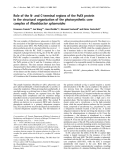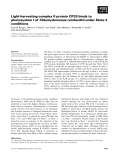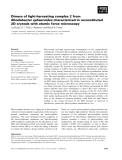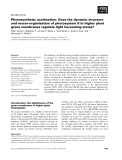
The light harvesting
-
Objectives of the study: Determination of technical parameters such as variety, nutrition, EC, pH, planting density and harvest time, which are suitable for growth, quality of spinach grown on recirculating hydroponic systems. From there, evaluation the effects of using artificial light (luminescence spectrum and light intensity) on the growth, yield and quality of spinach grown on recirculating hydroponic systems indoor.
 26p
26p  thebadguys
thebadguys
 08-06-2021
08-06-2021
 28
28
 4
4
 Download
Download
-
The organization of Arabidopsis thaliana photosystem II (PSII) and its associated light-harvesting antenna (LHCII) was studied in isolated PSII–LHCII supercomplexes and native membrane-bound crystals by transmission electron microscopy and image analysis. Over 4000 single-particle projections of PSII– LHCII supercomplexes were analyzed. In comparison to spinach supercomplexes [Boekema, E.J., van Roon, H., van Breemen, J.F.L. & Dekker, J.P. (1999) Eur. J. Biochem.
 9p
9p  system191
system191
 01-06-2013
01-06-2013
 31
31
 4
4
 Download
Download
-
The photosynthetic protein complexes in plants are located in the chloroplast thylakoid membranes. These membranes have an ultrastructure that consists of tightly stackedÔgranaÕ regions interconnectedbyunstackedmembrane regions.The structure of isolated granamembranes has been studiedhere by cryo-electron microscopy. The data reveals an unusual arrangement of the photosynthetic protein complexes, staggered over two tightly stacked planes.
 11p
11p  research12
research12
 29-04-2013
29-04-2013
 42
42
 2
2
 Download
Download
-
The core complex ofRhodobacter sphaeroidesis formed by the association of the light-harvesting antenna 1 (LH1) and the reaction center (RC). The PufX protein is essential for photosynthetic growth; it is locatedwithin the core in a 1 : 1 stoichiometry with the RC. PufX is required for a fast ubiquinol exchange between the QBsite of the RC and the Qo site of the cytochromebc1complex.
 9p
9p  research12
research12
 23-04-2013
23-04-2013
 33
33
 3
3
 Download
Download
-
The State 1 to State 2 transition in the photosynthetic membranes of plants and green algae involves the functional coupling of phosphorylated light-harvesting complexes of photosystem II (LHCII) to photosystem I (PSI). We present evidence suggesting that inChlamydomonas reinhardtiithis coupling may be aided by a hyper-phosphorylated form of the LHCII-like CP29 protein (Lhcbm4).
 10p
10p  fptmusic
fptmusic
 12-04-2013
12-04-2013
 35
35
 2
2
 Download
Download
-
Diatoms differ from higher plants by their antenna system, in terms of both polypeptide and pigment contents. A rapid isolation procedure was designed for the membrane-intrinsic light harvesting complexes (LHC) of the diatom Phaeodactylum tricornutumto establish whether different LHC subcomplexes exist, as well to determine an uneven distribution between them of pigments and polypeptides.
 10p
10p  fptmusic
fptmusic
 11-04-2013
11-04-2013
 47
47
 3
3
 Download
Download
-
We measured cocrystals of the membrane protein Photosystem I with its soluble electron acceptor ferredoxin for the first time at the ALS (Berkeley, CA). Previous data collected at our home source and at other synchrotron sources showed crystals with very high mosaicity (2–5%) and a diffraction limit to 7–8 Aresolution. This first beamtime at ALS was very successful and may represent a breakthrough for the determination of the crystal structure. 110 crystals, grown under modified crystallization conditions, were scanned and for the first time, crystals diffraction to 3.5 A were observed....
 17p
17p  fptmusic
fptmusic
 11-04-2013
11-04-2013
 31
31
 2
2
 Download
Download
-
We report on the results obtained by measuring the stoi-chiometry of antenna polypeptides in Photosystem I (PSI) fromArabidopsis thaliana. This analysis was performed by quantification of Coomassie blue binding to individual LHCI polypeptides, fractionation by SDS/PAGE, and by the use of recombinant light harvesting complex of Photo-system I (Lhca) holoproteins as a standard reference. Our results show that a single copy of each Lhca1–4 polypeptide is present in Photosystem I.
 0p
0p  awards
awards
 05-04-2013
05-04-2013
 31
31
 2
2
 Download
Download
-
Heme oxygenase (HO) catalyzes the oxidative degradation of heme utilizing molecular oxygen and reducing equiva-lents. In photosynthetic organisms, HO functions in the biosynthesis of such open-chain tetrapyrroles as phyto-chromobilin and phycobilins, which are involved in the sig-nal transduction for light responses and light harvesting for photosynthesis, respectively.
 9p
9p  awards
awards
 05-04-2013
05-04-2013
 31
31
 3
3
 Download
Download
-
The protein assembly and stability of photosystem II (PSII) (sub)complexes were studied inmature leaves of four plastid mutants of tobacco (Nicotiana tabacumL), each havingone of thepsbEFLJoperon genes inactivated. In the absence of psbL, no PSII core dimers or PSII–light harvesting complex (LHCII) supercomplexes were formed, and the assembly of CP43 into PSII core monomers was extremely labile. The assembly of CP43 intoPSII coremonomers was found to be necessary for the assembly of PsbO on the lumenal side of PSII. ...
 12p
12p  dell39
dell39
 03-04-2013
03-04-2013
 46
46
 3
3
 Download
Download
-
Microscopic and light spectroscopic investigations on the supramolecular architecture of bacterial photosynthetic membranes have revealed the pho-tosynthetic protein complexes to be arranged in a densely packed energy-transducing network.
 10p
10p  galaxyss3
galaxyss3
 07-03-2013
07-03-2013
 50
50
 3
3
 Download
Download
-
The core light-harvesting LH1 protein fromRhodospirillum rubrumcan dis-sociate reversibly in the presence ofn-octyl-b-d-glucopyranoside into smal-ler subunit forms, exhibiting a dramatic blue-shift in absorption. During this process, two main species are observed: a dimer that absorbs at 820 nm (B820) and a monomer absorbing at 777 nm (B777).
 8p
8p  media19
media19
 06-03-2013
06-03-2013
 38
38
 3
3
 Download
Download
-
The efficiency of light harvesting in higher plant photosynthesis is regulated in response to external environmental conditions. Under conditions of excess light, the normally highly efficient light-harvesting system of photo-system II is switched into a state in which unwanted, potentially harmful, energy is dissipated as heat.
 11p
11p  media19
media19
 06-03-2013
06-03-2013
 41
41
 4
4
 Download
Download
-
In order to carry out photosynthesis, plants and algae rely on the co-opera-tive interaction of two photosystems: photosystem I and photosystem II. For maximum efficiency, each photosystem should absorb the same amount of light.
 13p
13p  media19
media19
 06-03-2013
06-03-2013
 32
32
 2
2
 Download
Download
-
Native and Ca 2+ -depleted light-harvesting–reaction center core complexes (LH1–RC) from the photosynthetic bacterium Thermochromatium(Tch.) tepidum exhibit maximal LH1–Qy absorption at 915 and 889 nm, respec-tively. To understand the structural origins of the spectral variation, we performed spectroscopic and structure modeling investigations.
 11p
11p  vinaphone15
vinaphone15
 27-02-2013
27-02-2013
 51
51
 4
4
 Download
Download
CHỦ ĐỀ BẠN MUỐN TÌM




























